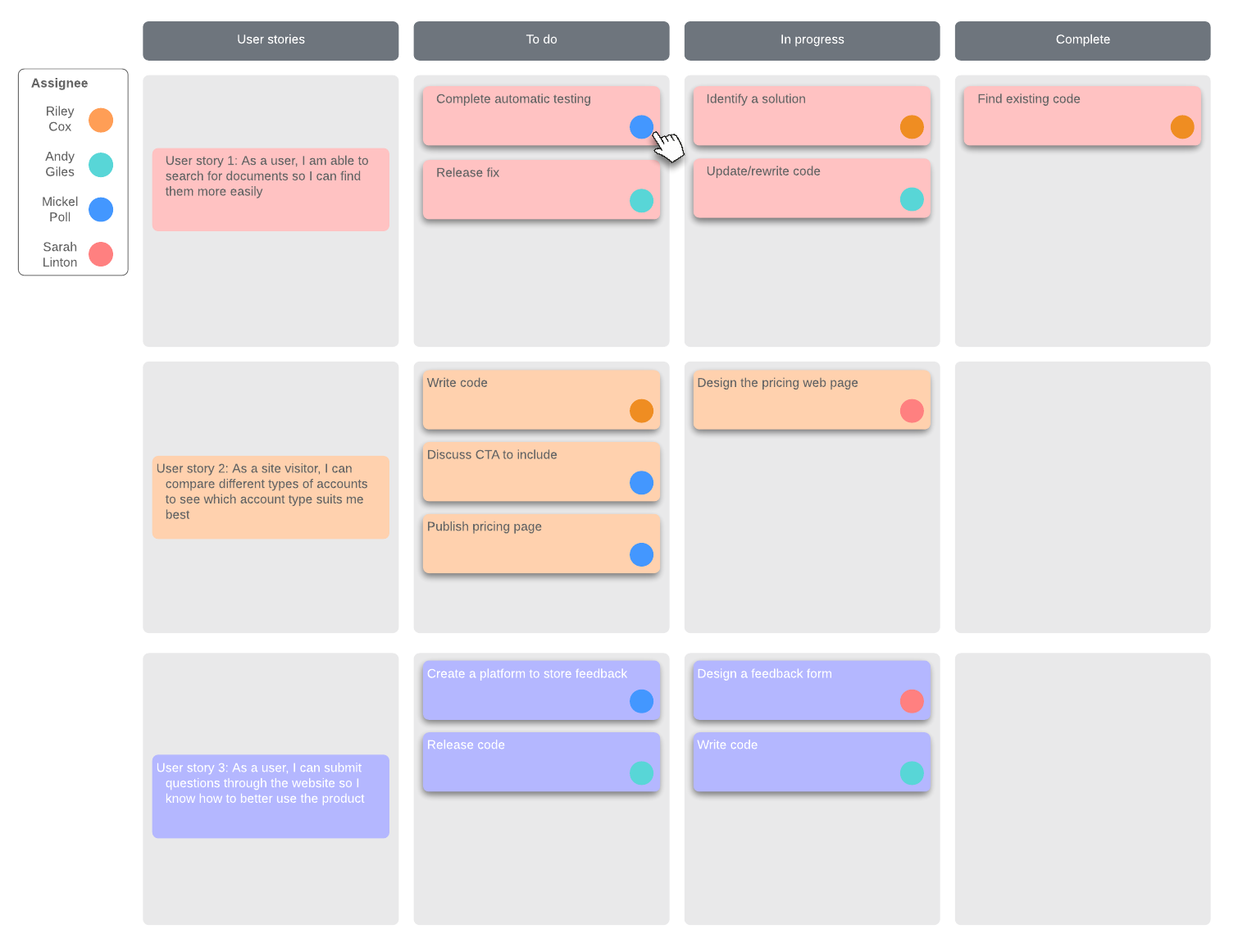
What is sprint planning? Benefits and potential pitfalls for your team
Lucid Content
Reading time: about 7 min
Topics:
Everywhere you look, it seems new products hit the market every day. Tech companies have to work faster to deliver more without compromising quality. But building and testing system-wide functionality and every little feature in a multidimensional product quickly enough to stay competitive is overwhelming, to say the least. Whether you’re building new software or making updates to existing products, the process requires solidarity within teams to mitigate risks and prevent compromises to existing systems.
Many teams have adopted Agile methodologies for software development and best practices for swift and high-quality software delivery.
To put Agile into practice, many use the Agile Scrum methodology to manage complex processes in teams, with an emphasis on working in sprints and sprint planning.
What is sprint planning?
While anyone can use sprint planning to manage projects, it traditionally stems from the Agile and Scrum methodology in software engineering. Sprint planning is incremental work, selected from a product backlog, that happens in short periods of time and is planned in advance. But keep in mind, while sprint planning is traditionally used in software development, the methodology can be used to manage any team's projects and individual workloads, yielding great benefits and productivity.
Sprint plans are Agile and Scrum events that guide what can and should be built by development teams and how. Typically, sprints are planned during a dedicated meeting where the Scrum team defines the scope and goal for the two-week period and details how each selected backlog item will help achieve the sprint goal.
When does sprint planning occur?
Planning and sprint length will vary with every business and project, but the Agile Scrum methodology suggests that teams dedicate two hours of planning for every week-long sprint. So, if your sprint is two weeks long, you would probably spend four hours actually planning your sprint.
Within the Agile software development lifecycle (SDLC), the goal is to produce a working product at the end of each sprint. So, sprints should be long enough to keep teams focused, yet long enough to build and test a quality deliverable. Some sprints may last more than a month but are typically two workweeks long. Each sprint includes multiple checkpoints, such as a daily standup or collaborative document, to give teams a chance to pivot or make changes as needed.
Roles involved in sprint planning
Teamwork is essential to successfully move from sprint to sprint. The following key players should be included in your team sprint planning meeting:
- Product owner: This role is essentially the primary stakeholder. This person manages the product backlog and clearly explains the content, availability, and order in which items will be worked on.
- Development team: who does the work of building and delivering an increment at the end of each sprint.
- Scrum master: This person is the meeting planner. In a non-development part of the business, it may just be a project manager. This person promotes Scrum practices and values and facilitates non-Scrum team interactions to maximize value and productivity.

Build a Scrum team structure for Agile development.
Learn howBenefits of sprint planning
The purpose of sprint plans is to ensure success through a shared and detailed understanding of the work ahead. Sprint planning helps teams control projects and better manage product backlog to deploy small parts of projects quicker and more frequently to enhance customer satisfaction.
Here are some key benefits of sprint planning:
Identify team capacities: Projects with lengthy product backlogs can often result in overcommitment and hurt efficiency in the long run. Sprints and sprint planning allow you to keep a constant pulse on team and individual bandwidth so no one person has too much or too little work.
Sprints also encourage teams to keep the big picture in mind but to focus on the necessary steps—rather than leaps—required to ensure there are no gaps or weaknesses in the product, such as key UX considerations.
Save time by managing expectations: Reviewing the backlog in advance as a team fosters discussion and consensus with the project owner around exactly which backlog items will be tackled in each sprint. By engaging in sprint collaboration, teams can monitor capacity and manage expectations, all of which can save time down the road.
Also, because projects are being tackled in chunks of work and reviewed more often, it allows for more frequent feedback loops. This way, you can flag issues or mistakes earlier in the project life cycle, rather than once at the end. This helps teams avoid significant rework and loss of time and resources.
Provide clarity and transparency: The Scrum master or project manager is likely going to advocate for transparency, inspection, and adaptation throughout each sprint. These three pillars of Scrum help move the team forward efficiently and can be easily put into practice with a digital Scrum board in Lucidchart.
The whole team can contribute to the document and see what they should be working on in each sprint, make suggestions if changes are needed, and see where other teams fit in.
Focus on the end goal: Sprint planning helps teams stay on track to hit the end goal. By managing smaller bits of work at a time, you can simultaneously focus on the immediate work to be done while constantly checking in to determine if each project task—and the timing of that task—support the end goal and the overall project timeline. Sprint planning helps all team members and stakeholders understand how each small task fits into the bigger picture without letting any element slip through the cracks.

Common sprint planning issues
While there are many benefits of sprint planning, teams may experience some of these common pitfalls.
Overcommitting: There’s always more work to be done and can result in overcommitment. The solution is to communicate the complexities and risks with stakeholders early on. it’s imperative to have an ongoing dialogue with your stakeholders so they understand why it may not be possible to deliver every element of the project by their imagined target deadline.
Spending too much time on the backlog: The solution is to consider a backlog refinement process and to evaluate and prioritize projects or elements in the backlog.
Too much upfront planning: A potential solution could be to define an outcome and a clear plan for success that provides "just enough" for the next sprint. The team focus should be on valuable outcomes, not overworked employees that deliver subpar results.
Delivering on sprint goals early: While this isn’t necessarily a downside, it’s important to manage everyone’s time efficiently as possible. So during sprint planning, a solution could be to ensure the product backlog is ordered and prioritized to allow the team to pick up the next prioritized work if they complete their sprint goals early.
No specific goal established: A sprint without a goal can leave employees feeling confused about how they’re contributing to the overall success of a project. A solution could be to include a specific goal for each sprint to ensure teams are performing entire sprints and can directly measure the progress made in relation to the work they spent that sprint and how they’re set up to succeed in the sprints ahead.
Confusing estimations with commitments: Most projects and stakeholders need to be flexible. A solution is to foster a trust-based and transparent environment where employees can be upfront about changes to project plans, capacity, or limitations.
Next steps
As you implement a sprint planning strategy on your team, keep the pitfalls in mind, but don't let them prevent you from trying. With the proper preparation, process, and people in place, you can reap all of the benefits that spring planning has to offer.

Learn how to hold a sprint retrospective meeting to make your entire Scrum process more efficient.
Read moreAbout Lucidchart
Lucidchart, a cloud-based intelligent diagramming application, is a core component of Lucid Software's Visual Collaboration Suite. This intuitive, cloud-based solution empowers teams to collaborate in real-time to build flowcharts, mockups, UML diagrams, customer journey maps, and more. Lucidchart propels teams forward to build the future faster. Lucid is proud to serve top businesses around the world, including customers such as Google, GE, and NBC Universal, and 99% of the Fortune 500. Lucid partners with industry leaders, including Google, Atlassian, and Microsoft. Since its founding, Lucid has received numerous awards for its products, business, and workplace culture. For more information, visit lucidchart.com.
